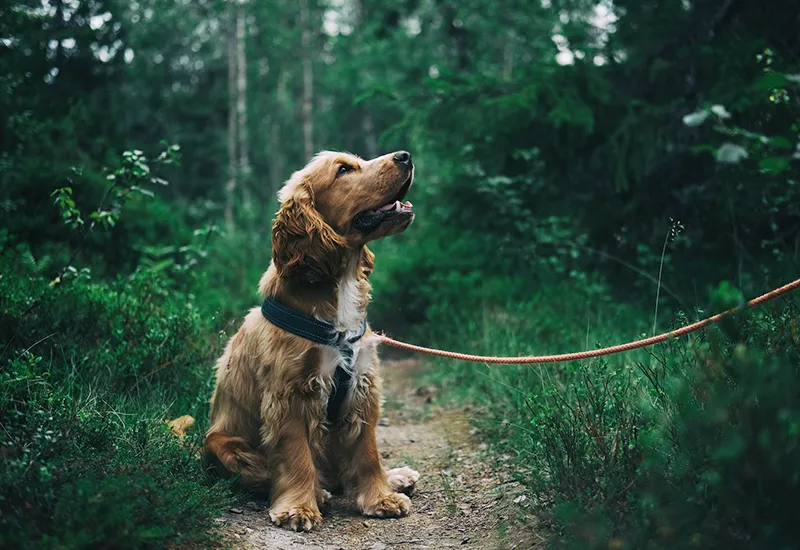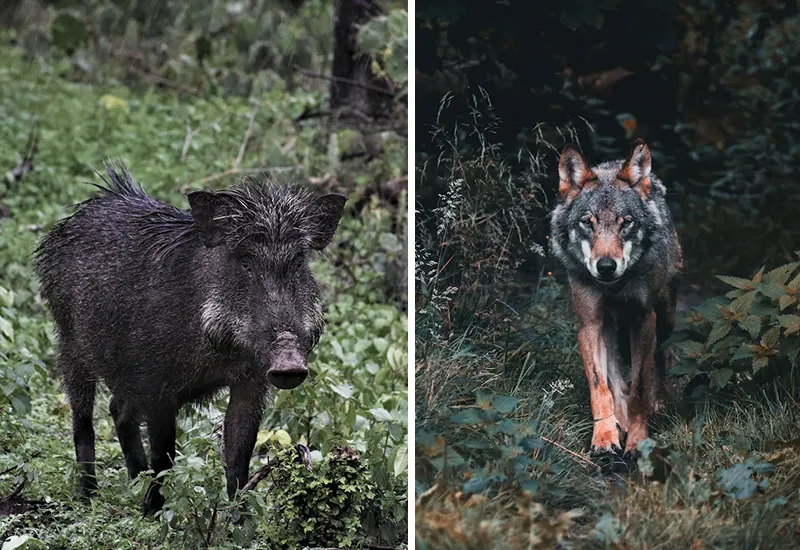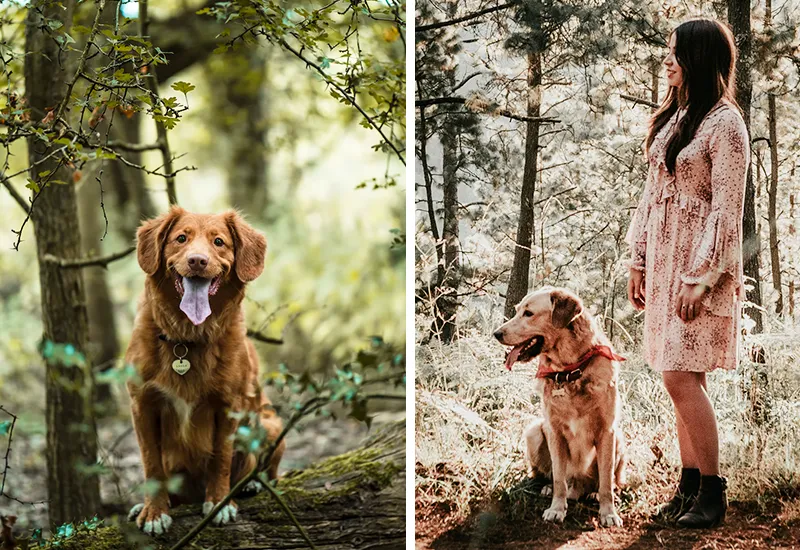How to walk safely and respectfully with the dog in the forest? If you're looking for helpful tips for relaxing walks in the woods with your four-legged companion, you've come to the right place!
As a dog owner:in you know how much your own dog loves to romp through the forest, explore the many smells and enjoy the freedom. But the forest is not only a playground, but also the habitat of many wild animals. We humans and our four-legged friends are only guests there. In order to make the forest walk pleasant for all involved, it is important to know and heed a few rules and tips.
In this article I would like to give you the ten most important tips and information for walking in the forest. Use them to be considerate of nature and at the same time give your dog a great experience. Let's go!
1. inform yourself about the leash obligation and adhere to it

The leash obligation in the forest serves both the protection of your dog and the protection of wild animals and other walkers. applies in most German federal states throughout the year. In some forest areas or regions (e.g. in Lower Saxony) dogs are only allowed to run without a leash outside the closed season or even completely free (e.g. in Bavaria).
However, I advise you to do so regardless of the leash requirement, always leash your dog in the forest (e.g. with a slightly longer drag line) and do not let him run free.
Because apart from possible fines, in many places hunting conservationists are allowed to shoot a dog that poaches in the forest. Furthermore, the Behavior of dogs in forests generally not completely predictable.
2. observe the breeding and setting times
According to Forest etiquette it is good manners to stay on the designated forest paths, not to leave trash, not to cut down trees, not to make noise at night, and not to go into the forest at all during thunderstorms or storms.
However, anyone who is out and about in the forest with their dog should also be sure to observe the breeding and setting times. This means especially the Months from March to July meant, where wild birds breed and the furred game gets and raises its offspring.
For example, an uncontrolled dog could destroy nests, rush pregnant deer to death, or frighten parent animals into leaving their offspring alone. Accordingly, it is important to adhere to the Leash obligation in the breeding and sowing season to hold, especially in the period mentioned to be particularly careful and leave the animals alone.
3. be considerate of wildlife and their habitat
As I said, together with our dog we are only guests in the forest. The wild animals welcome us in their home, so we should also behave sensibly. Stay on the forest paths, don't trample anything, leash your dog, and especially avoid sensitive areas like breeding grounds or water sources. This is also wildlife protection.
A respectful treatment of the wildlife habitat contributes not least to the Biodiversity conservation with. After all, the animals already have enough under the Deforestation to suffer at the hands of us humans.
Important: Of course, you should also be considerate when dealing with other forest visitors. If you meet a walker with a dog, you should put your dog on a leash at the latest.
4. train basic obedience and recall in advance
If you have discovered walking in the woods for yourself, you should make sure that the dog hears and comes when you call him to you. If he responds appropriately to your recall and other commands, the Prevent critical situations and make the walk more pleasant for all involved. Because a well-trained dog is of course easier to handle in the forest and can also run free rather times without a leash.
I once had the situation myself that I had to give my Dog lost in the forest and did not know what to do. If your dog also runs away: It is indeed best to wait at the respective (preferably well visible) place and report the loss of the dog to the nearest police station and/or the public order office.
To such Avoid stress for all involvedYou should train your dog accordingly. The recall can be trained, for example, by calling him regularly with a friendly voice, a clear command (e.g. "Come-come") and inviting body posture to you and then reward him with a treat.
5. be prepared for unexpected encounters with wild animals

Of course, encounters with aggressive wild animals like a wolf are very unlikely, but possible. Knowing what to do in the event of such dangers can help both protect you, your dog as well as the wild animal.
If you meet a wolf, you should address him loudly and clap your hands. This will usually drive him away. The best protection, however, is to keep your Dog always on the leash to have when you're hanging out together in wolf territory.
However, it is somewhat more likely to make acquaintance with a wild boar. Here it is important to remain calm and to slowly back away together with your dog. If he is not on the leash, you must call him to you as soon as possible or lure him to you with a treat.
6. do not let your dog eat anything from the forest
What you also need to pay attention to when walking with your dog in the forest is that he does not suddenly eat something. After all, the forest is home to many things (especially poisonous plants, mushrooms, berries and unfortunately also placed by human hand Poison bait), which can be fatal to dogs. Also on found Bones he should not chew, of course.
So to avoid serious health consequences for your dog, it is best to leash him. What to do if your dog has eaten something in the forest? I would immediately at the first suspicion go to the veterinary clinic or veterinarian - especially when the dog behaves strangely.
Tip: What dogs generally should not eatBy the way, you can read more about this in the linked, detailed blog article.
7. remove your dog's droppings
When you are out and about in the forest with your dog, you should of course always pick up the dog excrement and not just leave it lying around. After all, it can also contain bacteria and worms, so that Transmit diseases to wildlife.
However, a single dog poop may not be that big of a problem - the Total dog poop from all forest visitors and their four-legged friends, however, do. Therefore, set a good example, always take a Dog waste bags collect the excrement and dispose of it at home in the residual waste.
Tip: If you're walking through the woods with your dog anyway, you can also take another small bag with you and pick up some litter when you find it. This way you can give your Take a walk and at the same time still something against the Plastic waste in the environment do
8. take fresh drinking water with you
If you are planning a longer walk or it is outside in the fresh air is quite hotYou should definitely always have a water bottle with fresh water for your dog. Because even if the dense trees of the forest already cool down a bit, the usually still sultry air and the high temperature can cause your Dog dehydrated.
9. protect your dog from ticks
Unfortunately, dogs can also participate in Lyme disease or the Early summer meningoencephalitis which is transmitted by tick bites. And the little animals like to live especially where it is green - so in the forest, undergrowth, flat grasses, bushes and shrubs.
To protect your dog from ticks, you should, in consultation with the vet or veterinarian, with him at regular intervals Take prophylaxis against ticks.
But be careful: Synthetic insecticides harm not only the dog, but also the environment. The dog may with a spot-on preparation under no circumstances into a natural body of waterOtherwise, it may kill or cause lasting damage to local living organisms.
Fortunately, there is a whole range of natural means against ticks (e.g. garlic, black cumin oil or brewer's yeast), so that strong insecticides only have to be resorted to in exceptional cases.
Apart from the anti-tick remedies, you should of course avoid forests where your dog constantly roams through the grass and where the blood-sucking ectoparasites, according to experience, especially like to wait for you. In addition, it is again more than advisable in this case, to stay on the forest paths at all times.
10. like to use the forest to train your dog

In the forest, dogs are of course allowed to have fun and be occupied despite the leash requirement! The diverse structures and charms of the forest can be wonderfully used, for example, as a Training environment use
What you can practice with the dog in the forest? One idea would be, for example, the targeted scent work by the Mantrailing. Your dog can sniff out another person in the forest. Of course, this also works as a somewhat simpler search game with a specific object, such as a food bag. Another suggestion? Balancing on fallen tree trunks also gives dogs great pleasure.
Through joint activities in the forest you promote finally above all the concentration and the body feeling of your dog. But always be careful not to cause any damage and not to disturb the wild inhabitants of the forest.
Tip: How you can help especially anxious and insecure Give dogs other security I'll be happy to explain how you can do this in the linked article.
Walking the dog in the forest? No problem!
A walk in the forest can be an unforgettable and fun experience for you and your dog. However, always remember that the forest does not belong to you, but to its inhabitants. It is a complex, sensitive ecosystem and home to numerous wild animals and plants. So always be attentive and walk considerately and respectfully with your four-legged friend through the forest.
"Some people go through the forest seeing nothing else but firewood."
Leo Tolstoy (more at Forest Quotes)
Finally, I would like to give you here some suitable, further articles that might also be of interest to you:
- Adopt dog from animal shelter
- Save the rainforest - What you can do for the tropical forests
- Feeding dogs a vegetarian or vegan diet - Is it possible?
- Forest bathing - What's behind it?
I hope the tips from this article help you enjoy a respectful and safe walk in the woods with your dog. Do you have any questions, suggestions, or more advice and information to take to heart when walking in the woods? Then I look forward to your comment.
Stay animal and environmentally friendly,

PS: Are dogs actually climate sinners? In the linked article, you will now find out whether there is perhaps a shred of truth behind this steep thesis and how you can improve the carbon footprint of your four-legged friend if necessary. Have fun!





